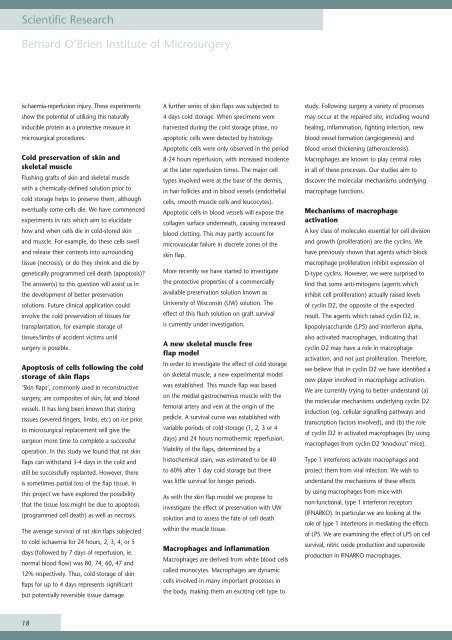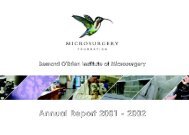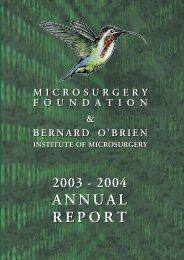2990 Microsurgery.qxd - O'Brien Institute
2990 Microsurgery.qxd - O'Brien Institute
2990 Microsurgery.qxd - O'Brien Institute
You also want an ePaper? Increase the reach of your titles
YUMPU automatically turns print PDFs into web optimized ePapers that Google loves.
Scientific Research<br />
Bernard O’Brien <strong>Institute</strong> of <strong>Microsurgery</strong><br />
ischaemia-reperfusion injury. These experiments<br />
show the potential of utilizing this naturally<br />
inducible protein as a protective measure in<br />
microsurgical procedures.<br />
Cold preservation of skin and<br />
skeletal muscle<br />
Flushing grafts of skin and skeletal muscle<br />
with a chemically-defined solution prior to<br />
cold storage helps to preserve them, although<br />
eventually some cells die. We have commenced<br />
experiments in rats which aim to elucidate<br />
how and when cells die in cold-stored skin<br />
and muscle. For example, do these cells swell<br />
and release their contents into surrounding<br />
tissue (necrosis), or do they shrink and die by<br />
genetically programmed cell death (apoptosis)?<br />
The answer(s) to this question will assist us in<br />
the development of better preservation<br />
solutions. Future clinical application could<br />
involve the cold preservation of tissues for<br />
transplantation, for example storage of<br />
tissues/limbs of accident victims until<br />
surgery is possible.<br />
Apoptosis of cells following the cold<br />
storage of skin flaps<br />
‘Skin flaps’, commonly used in reconstructive<br />
surgery, are composites of skin, fat and blood<br />
vessels. It has long been known that storing<br />
tissues (severed fingers, limbs, etc) on ice prior<br />
to microsurgical replacement will give the<br />
surgeon more time to complete a successful<br />
operation. In this study we found that rat skin<br />
flaps can withstand 3-4 days in the cold and<br />
still be successfully replanted. However, there<br />
is sometimes partial loss of the flap tissue. In<br />
this project we have explored the possibility<br />
that the tissue loss might be due to apoptosis<br />
(programmed cell death) as well as necrosis.<br />
The average survival of rat skin flaps subjected<br />
to cold ischaemia for 24 hours, 2, 3, 4, or 5<br />
days (followed by 7 days of reperfusion, ie.<br />
normal blood flow) was 80, 74, 60, 47 and<br />
12% respectively. Thus, cold storage of skin<br />
flaps for up to 4 days represents significant<br />
but potentially reversible tissue damage.<br />
A further series of skin flaps was subjected to<br />
4 days cold storage. When specimens were<br />
harvested during the cold storage phase, no<br />
apoptotic cells were detected by histology.<br />
Apoptotic cells were only observed in the period<br />
8-24 hours reperfusion, with increased incidence<br />
at the later reperfusion times. The major cell<br />
types involved were at the base of the dermis,<br />
in hair follicles and in blood vessels (endothelial<br />
cells, smooth muscle cells and leucocytes).<br />
Apoptotic cells in blood vessels will expose the<br />
collagen surface underneath, causing increased<br />
blood clotting. This may partly account for<br />
microvascular failure in discrete zones of the<br />
skin flap.<br />
More recently we have started to investigate<br />
the protective properties of a commercially<br />
available preservation solution known as<br />
University of Wisconsin (UW) solution. The<br />
effect of this flush solution on graft survival<br />
is currently under investigation.<br />
A new skeletal muscle free<br />
flap model<br />
In order to investigate the effect of cold storage<br />
on skeletal muscle, a new experimental model<br />
was established. This muscle flap was based<br />
on the medial gastrocnemius muscle with the<br />
femoral artery and vein at the origin of the<br />
pedicle. A survival curve was established with<br />
variable periods of cold storage (1, 2, 3 or 4<br />
days) and 24 hours normothermic reperfusion.<br />
Viability of the flaps, determined by a<br />
histochemical stain, was estimated to be 40<br />
to 60% after 1 day cold storage but there<br />
was little survival for longer periods.<br />
As with the skin flap model we propose to<br />
investigate the effect of preservation with UW<br />
solution and to assess the fate of cell death<br />
within the muscle tissue.<br />
Macrophages and inflammation<br />
Macrophages are derived from white blood cells<br />
called monocytes. Macrophages are dynamic<br />
cells involved in many important processes in<br />
the body, making them an exciting cell type to<br />
study. Following surgery a variety of processes<br />
may occur at the repaired site, including wound<br />
healing, inflammation, fighting infection, new<br />
blood vessel formation (angiogenesis) and<br />
blood vessel thickening (atherosclerosis).<br />
Macrophages are known to play central roles<br />
in all of these processes. Our studies aim to<br />
discover the molecular mechanisms underlying<br />
macrophage functions.<br />
Mechanisms of macrophage<br />
activation<br />
A key class of molecules essential for cell division<br />
and growth (proliferation) are the cyclins. We<br />
have previously shown that agents which block<br />
macrophage proliferation inhibit expression of<br />
D-type cyclins. However, we were surprised to<br />
find that some anti-mitogens (agents which<br />
inhibit cell proliferation) actually raised levels<br />
of cyclin D2, the opposite of the expected<br />
result. The agents which raised cyclin D2, ie.<br />
lipopolysaccharide (LPS) and interferon alpha,<br />
also activated macrophages, indicating that<br />
cyclin D2 may have a role in macrophage<br />
activation, and not just proliferation. Therefore,<br />
we believe that in cyclin D2 we have identified a<br />
new player involved in macrophage activation.<br />
We are currently trying to better understand (a)<br />
the molecular mechanisms underlying cyclin D2<br />
induction (eg. cellular signalling pathways and<br />
transcription factors involved), and (b) the role<br />
of cyclin D2 in activated macrophages (by using<br />
macrophages from cyclin D2 ‘knockout’ mice).<br />
Type 1 interferons activate macrophages and<br />
protect them from viral infection. We wish to<br />
understand the mechanisms of these effects<br />
by using macrophages from mice with<br />
non-functional, type 1 interferon receptors<br />
(IFNARKO). In particular we are looking at the<br />
role of type 1 interferons in mediating the effects<br />
of LPS. We are examining the effect of LPS on cell<br />
survival, nitric oxide production and superoxide<br />
production in IFNARKO macrophages.<br />
18






